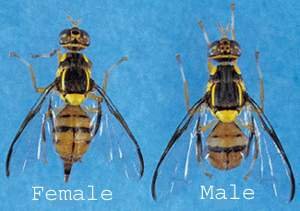An infestation of oriental fruit flies has struck Morgan Hill, with official word coming from the Santa Clara County Department of Agriculture Thursday afternoon.
“It’s a very serious pest and can be very destructive,” said Kevin O’Day the county’s agriculture commissioner.
The California Secretary of Agriculture issued a proclamation declaring an emergency Friday that authorizes the eradication process. O’Day said it’s not a quarantine – wherein local crops cannot be moved – but an infestation that he predicts will be solved with an eradication process.
Workers will treat an area of approximately 16-square miles as part of this eradication effort. The treatment area is roughly bounded by Cochrane Road on the north, Hill Road on the east, San Martin Avenue on the south, and Oak Glen Avenue on the west.
Four flies were found in the area of Tennant Avenue and Monterey Road in Morgan Hill – the first was found in an insect detection trap (part of the state’s early detection program) Monday and confirmed by the California Department of Food and Agriculture in Sacramento Tuesday; a second fly was found Tuesday after more traps were laid; and the third fly was located Wednesday.
The oriental fruit fly is not native to the continental United States – it’s native to Southern Asia. It has the ability to infest more than 230 host plants from peaches to plums to peppers to cucumbers, said O’Day. He said that infestations have occurred in California over the last 30 years and have been successfully wiped out before any critical damage. The fruit fly is typically found in urban areas, he said, because they “hitchhike” on fruit that is from an infested area such as Hawaii or the Philippines.
In the past few weeks, this invasive pest has also been found in the Orange County, according to the county.
The tiny flies – about the size of a pin head – burrow inside fruit, lay eggs and populate. If not eradicated, they threaten a multimillion dollar industry.
The next step is for traps to be set in the area of Tennant and Monterey and several miles out.
“Every grower is always concerned and aware of invasive species, more so than the general public. Because of where Santa Clara County is, we have international travelers and trade and a population that is highly mobile, so we’re at risk for evasive species and hitchhiking pests,” O’Day said.
Treament for the oriental fruit fly is a kind of bate station with thick geli substance of female insect pheromones and pesticides that attracts the male fruit fly. That substance is placed high in the air on trees along streets in the area and telephone polls.
“The male fruit fly lands on the goopy spot and it dies, so the female can’t lay eggs, so the population collapses,” O’Day said. That treatment will go on for about a month, until the species in eradicated altogether.
The last infestation in the county was in Milpitas in 2010 causing major concern, and it was fully eradicated in July 2011, according to the county.
O’Day reminds people that it’s extremely important to not bring any fruits or vegetables home from your travels, unless they have been properly treated or cleared by an authorized agricultural official.
If three more flies are found in the area, Santa Clara County will enter an official quarantine. With 50 traps set up every square mile, Jennifer Scheer, director of the Santa Clara County Farm Bureau, said it’s only a matter of days before the county will determine whether or not a quarantine will be issued.
Farmers in Morgan Hill wait nervously for the verdict. Ian Teresi of George Chiala Farms said the quarantine would be a “double whammy” of destruction – hitting farmers on all sides by rotting their crops, placing a hold on shipment and costing each grower thousands of dollars for the spray treatment.
“These flies are pretty ferocious and reproduce pretty fast,” Teresi said. “It’s devastating any way you look at it.” The four-week spray treatment would cost each farmer $160 per acre, Teresi said. With about 60 acres of bell pepper crops, Teresi would be looking at a $9,000, not to mention the money lost from rotted crops.
Ben Scorcer, a wine grape grower in San Martin, said he’s crossing his fingers that the infestation gets under control soon before it gets worse.
“It’s so important that this thing is taken care of before it expands out to all of the agricultural community,” Scorcer said.













